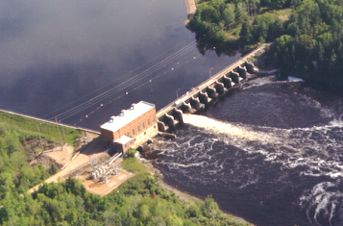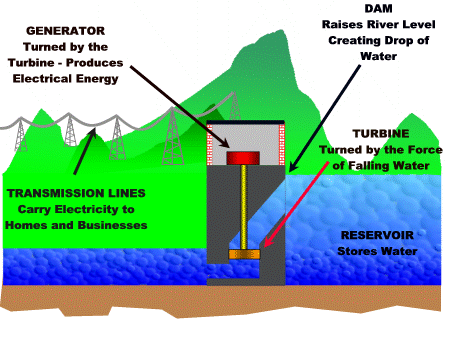Oscillating Water Column
Salter Duck

Oscillating Water Column
The Mighty Whale prototype is 50 m long and 30 m wide and carries three air turbine generator units: one with a rated output of 50 kW + 10 kW and two of 30 kW.
After being towed to its mooring about 1.5 km from the mouth of Gokasho Bay, the Mighty Whale was anchored to the bottom of the sea (about 40 m deep) with six mooring lines; four lines on the seaward side and two on the lee side. The moorings are designed to withstand even typhoon strength wind and waves.
The Mighty Whale can be remotely controlled from on-shore. In the demonstration prototype, the energy produced is mostly used by the instruments carried on board; any surplus is used to charge a storage battery or, when this is fully charged, is used by a loading resistor. A safety valve protects the air turbines from stormy weather by shutting off the flow of air if the rotation speed of the turbines exceeds a predetermined level. So that it can be used in the future to improve water quality, the prototype is also equipped with an air compressor to provide aeration.
During the demonstration project, instruments aboard the Mighty Whale are monitoring the various factors that might affect its operation (see data in Tables 1, 2 and 3). The data are stored on board, but those relating to the safety of the Mighty Whale, and the operation of the monitoring equipment are transmitted to the on-shore control station.
The World's largest offshore floating wave power device was launched in July 1998 by the Japan Marine Science and Technology Center. The full-scale prototype will be demonstrated and tested over a two-year period at the mouth of Gokasho Bay facing the Pacific Ocean.
The principle
The Mighty Whale converts wave energy to electricity by using oscillating columns of water to drive air turbines. As shown in the figure above, waves flowing in and out of the air chambers at the 'mouth' of the Mighty Whale make the water level in the chambers rise and fall. The water forces air into and out of the chambers through nozzles on the tops of the chambers. The resulting high-speed air-flows rotate air turbines which drive the generators.

Because it has absorbed and converted most of the energy in the wave, the Mightly Whale also creates calm sea space behind it, and this feature can be utilised; for example, to make areas suitable for fish farming and water sports. The structure of the Mighty Whale itself can be used as a weather monitoring station, a temporary mooring for small vessels or a recreational fishing platform. As well as generating energy for use on-shore, the Mighty Whale can provide an intermediate energy source for aeration to improve water quality.

The Oscillating Water Column generates electricity in a two step process. As a wave enters the column, it forces the air in the column up the closed column past a turbine, and increases the pressure within the column. As the wave retreats, the air is drawn back past the turbine due to the reduced air pressure on the ocean side of turbine.
Much research is occurring internationally to develop oscillating water columns which require less stringent siting conditions, including the OSPREY and floating columns, such as the Japanese Mighty Whale.
Salter Duck

The Salter Duck, Clam, Archimedes wave swing and other floating wave energy devices generate electricity through the harmonic motion of the floating part of the device, as opposed to fixed systems which use a fixed turbine which is powered by the motion of the wave. In these systems, the devices rise and fall according to the motion of the wave and electricity is generated through there motion.

The Salter Duck is able to produce energy extremely efficiently, however its development was stalled during the 1980s due to a miscalculation in the cost of energy production by a factor of 10 and it has only been in recent years when the technology was reassessed and the error identified.

http://earthsci.org/mineral/energy/hydro/hydro.html
Hydro Power

The Four Major Components
How Much Electricity Can a Hydroelectric Plant Make
Hydroelectric power plants capture the energy of falling water to generate electricity. A turbine converts the kinetic energy of falling water into mechanical energy. Then a generator converts the mechanical energy from the turbine into electrical energy.
Hydroplants range in size from "micro-hydros" that power only a few homes to huge schemes like the Snowy River System that provide electricity for millions of people.
graphic below):

Raises the water level of the river to create falling water.
Also controls the flow of water. The reservoir that is formed is, in effect,
stored energy. Turbine The force of falling water pushing against the turbine's blades causes the turbine to spin. A water turbine is much like a windmill, except the energy is provided by falling water instead of wind. The turbine converts the kinetic energy of falling water into mechanical energy. Generator Connected to the turbine by shafts and possibly gears so
when the turbine spins it causes the generator to spin also. Converts the
mechanical energy from the turbine into electric energy. Generators in
hydropower plants work just like the generators in other types of power
plants. Transmission lines Conduct electricity from the hydropower plant to homes and business.
How Much Electricity Can a Hydroelectric Plant Make?
The amount of electricity a hydropower plant produces depends on two
factors:
How Far the Water Falls.
The farther the water falls, the more power it has. Generally, the distance that the water falls depends on the size of the dam. The higher the dam, the farther the water falls and the more power it has. Scientists would say that the power of falling water is "directly proportional" to the distance it falls. In other words, water falling twice as far has twice as much energy. More water falling through the turbine will produce more power. The amount of water available depends on the amount of water flowing down the river. Bigger rivers have more flowing water and can produce more energy. Power is also directly proportional" to river flow. A river with twice the amount of flowing water as another river can produce twice as much energy.
No comments:
Post a Comment